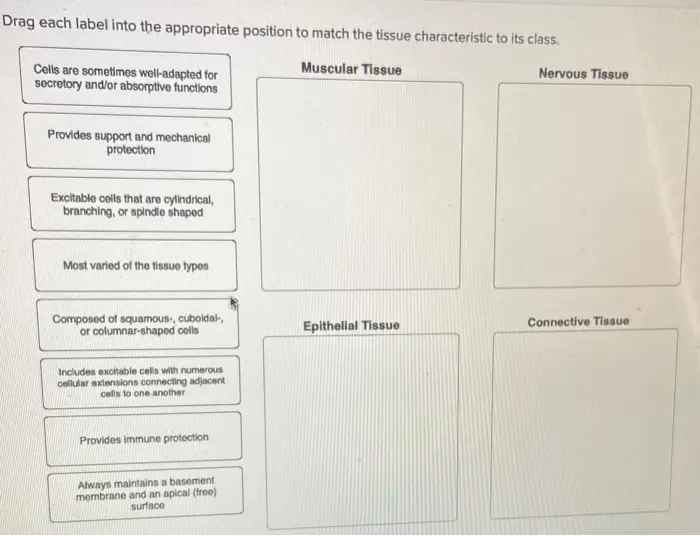 Drag each label into the appropriate position to match the tissue characteristic to its class. Muscular Tissue Cells are sometimes well-adapted for secretory and/or absorptive functions Nervous Tissue Provides support and mechanical protection Excitable cells that are cylindrical, branching, or spindle shaped Most varied of the tissue types Composed of squamous, cuboldal-, or columnar-shaped cells Epithelial Tissue Connective Tissue Includes excitable cells with numerous cellular extensions connecting adjacent cells to one another Provides immune protection Always maintains a basement membrane and an apical (free) surface
Drag each label into the appropriate position to match the tissue characteristic to its class. Muscular Tissue Cells are sometimes well-adapted for secretory and/or absorptive functions Nervous Tissue Provides support and mechanical protection Excitable cells that are cylindrical, branching, or spindle shaped Most varied of the tissue types Composed of squamous, cuboldal-, or columnar-shaped cells Epithelial Tissue Connective Tissue Includes excitable cells with numerous cellular extensions connecting adjacent cells to one another Provides immune protection Always maintains a basement membrane and an apical (free) surface
1. Muscular tissue.
Excitable cells that are cylindrical, branching, or spindle
shaped
2. Nervous tissue.
Includes excitable cells with numerous cellular extensions
connecting adjacent cells to one another.
3. Epithelial tissue.
Cells are sometimes well adapted for secretory and / or
absorptive function.
Composed of squamous, cuboidal, or columnar shaped cells.
Always maintains a basement membrane and an apical (free)
surface.
4. Connective tissue.
Most varied of the tissue types.
Provides support and mechanical protection.
Provides immune protection.
- OpenGL Drivers - April 11, 2024
- Turn work or office laptop into personal laptop - April 11, 2024
- 2018-11 Update for Windows 10 Version 1803 for x64-based Systems (KB4023057) – Error 0x80070643 - April 11, 2024
